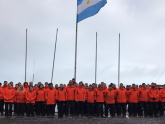The Carlini Base completed 39 years of operation as the main permanent scientific facility in Argentine Antarctica, where research in numerous areas is carried out.
The base, located on Potter Cove, 25 de Mayo Island, is administered and operated by the National Antarctic Directorate (DNA), dependent on the Ministry of Foreign Affairs.
The most relevant scientific research carried out in Carlini covers marine and terrestrial biology, oceanography, geology and glaciology. These activities have been carried out without interruption for more than two decades, which has enabled a collection of scientific data that is among the oldest and most complete in the Antarctic region.
“We feel an enormous pride for the work and effort daily made by those who, from the Carlini Base, make effective the commitment to sovereignty, international cooperation, peace and environmental protection”, said the Secretary of Malvinas, Antarctica and South Atlantic, Daniel Filmus, who also highlighted that “this year we are going to celebrate the 70th anniversary of the Argentine Antarctic Institute (IAA), the world's first scientific institution exclusively dedicated to the study of Antarctica”.
The origin of the base dates back to 1953, when the Argentine Navy installed the Potter Cove Naval Shelter, later Naval Air Station. In 1954 it was named after Lieutenant José Isidro Jubany, a Naval Aviation pilot who had died in a plane crash. Reclassified as a Naval Detachment, on February 12, 1982 it was transferred to the DNA-IAA and was named Jubany Scientific Station, until March 2012 when it was renamed in homage to Dr. Alejandro Ricardo Carlini, renowned scientist of the Antarctic Institute.
The IAA, also dependant on the Ministry of Foreign Affairs, controls and executes the scientific projects that are developed in Carlini throughout the year, while the Antarctic Directorate of the Army provides staff for logistical tasks, including divers who, with the protection of a hyperbaric chamber in the base, collect samples, even under ice, and collaborate with multiple research projects. Part of the scientific tasks are carried out from the Argentinean refuges Elefante and Albatros, which are located nearby. The base has the Carlini Multidisciplinary Antarctic Laboratory (LACAR) and the Argentine Laboratory, both managed by the IAA. At LACAR, studies of the atmosphere are carried out, in particular on the greenhouse effect and climate change.
The base area has a great biodiversity of fauna and flora. Among the birds, the skuas, petrels and three species of penguins stand out. The area also has very abundant mammal populations, such as elephant seals, double-coated sea lions, and species of seals such as the Leopard, the Weddell and the Cangrejera. The vegetation exhibits a great coverage with the presence of a species of Antarctic grass, mosses and lichen. Moreover, underwater life is home to rich communities of fish, invertebrates and benthic algae.
The Dallman Laboratory has also operated at Carlini since 1994 through an agreement with the Alfred Wegener Institute of Germany. Scientists from other countries with which there are international agreements also work in its four laboratories, its aquarium and the rest of its facilities. Furthermore, through an agreement with the National Institute of Oceanography and Experimental Geophysics of Trieste in Italy, a permanent seismological station was installed in 2001.


